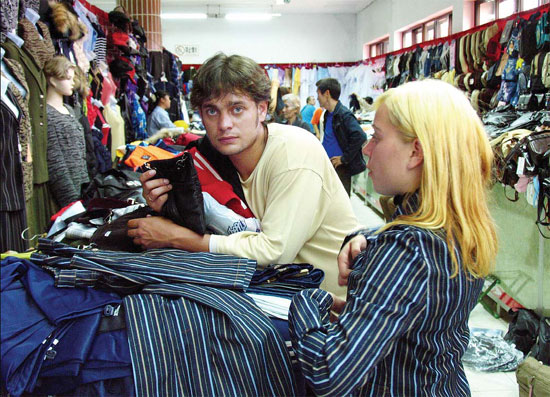China builds on border trade
Updated: 2013-03-04 07:50
By Li Jiabao in Beijing and Wang Kaihao in Manzhouli, Inner Monglia (China Daily)
|
|||||||||||
|
Two Russian businesspeople in a garment market in Manzhouli in North China's Inner Mongolia autonomous region. Border trade has brought prominence to Manzhouli as China's largest inland port, accounting for about 70 percent of land trade between China and Russia. Amid deepening China-Russia ties, the city, with a population of 300,000 in 2012 and a size of 732 square kilometers, is experiencing a new boom. Liu Zhaoming / For China Daily |
Russia's entry to WTO creates huge opportunities for entrepreneurship
Russia's accession to the World Trade Organization and the consequent tariff reduction with China implies promising opportunities for Chinese businesses as border trade between the two countries is expected to boom.
"We have finished production for all the orders before May," said Ge Shengchun, general manager of Jasmine Glass Technology Co based in Manzhouli, a city in Northeast China's Inner Mongolia autonomous region that borders Russia to the north and Mongolia to the west.
Ge set up the 20,000-square- kilometer glass plant in 2008 with an investment of 250 million yuan ($40.05 million). About 90 percent of his products, including concave glass, frosted glass and armoured glass, were sold to Russia and cornered more than half of the markets in cities in the Russian Far East, including Chita, Ulan-Ude and Irkutsk.
"Our priority is not the Chinese market. We are diversifying out overseas markets to reduce risks. We will enter the Hungary market this year and may set up sales networks in South Asian countries such as India in the future," he said.
Another regional businessman, Yu Hongwei, deputy manager of Manzhouli Yiliya Fruits Trade Co, said: "Price is our biggest competitive edge. Our product quality is in the middle level."
The company exports about 40,000 tons of vegetables and fruits to Russia every year, about 10 percent of Manzhouli's total fresh food exports. Tomatoes account for the biggest share. A total of 320,000 tons of vegetables and fruits passed through the Manzhouli customs' Shibali port in 2012. A specially dedicated lane reduced the one-time hour-long passage to less than 20 minutes, according to the port's deputy director Liu Juan.
Border trade has brought prominence to Manzhouli as China's largest inland port, accounting for about 70 percent of land trade between China and Russia. Amid deepening China-Russia ties, the city, with a population of 300,000 in 2012 and a size of 732 sq km, is facing a new boom. China's determination to open up inland regions and Russia's accession to the WTO is set to improve trade and investment environments.
The two nations' bilateral trade saw an increase of 7.1 percent year-on-year to reach $7.68 billion in January, while China's exports rose 26 percent compared with the same month in 2012, according to the Ministry of Commerce.
Accession to WTO
Russia was accepted as the 156th member of the WTO on Aug 22, 2012, with a process of accession of more than 19 years.
At the end of the implementation period, the average tariff ceiling for Russian imported products will be lowered to 7.8 percent from the average 10 percent that was applied before accession. The average tariff ceiling for manufactured products will be 7.3 percent instead of 9.5 percent while the average tariff ceiling for agricultural goods will be 10.8 percent instead of the earlier average of 13.2 percent.
In addition, Russia has offered improved market access opportunities in certain areas of goods and in many service sectors, according to the WTO.
Related Stories
Border trade blossoming 2013-01-14 20:48
Heilongjiang gives priority to border trade 2012-05-01 11:15
NE China to boost Sino-Russian border trade 2012-03-13 15:43
China extends cross-border trade settlement in yuan 2011-08-24 09:42
More policies to support cross-border use of renminbi 2013-03-02 09:56
Cross-border yuan trade pilot programs 2012-11-20 14:25
Today's Top News
Police continue manhunt for 2nd bombing suspect
H7N9 flu transmission studied
8% growth predicted for Q2
Nuke reactor gets foreign contract
First couple on Time's list of most influential
'Green' awareness levels drop in Beijing
Palace Museum spruces up
Trading channels 'need to broaden'
Hot Topics
Lunar probe , China growth forecasts, Emission rules get tougher, China seen through 'colored lens', International board,
Editor's Picks

|

|

|

|

|

|






